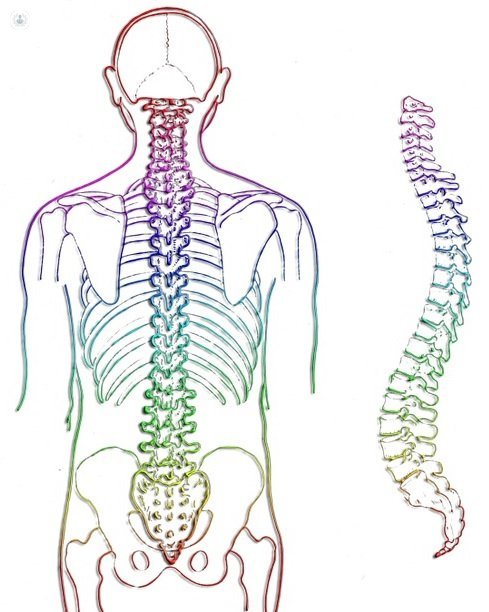Spinal surgery
Written by:Since the spinal column or column occupies almost the entire skeleton in length, structure and anatomical relationships are different if located in the neck, chest or lower back and this phenomenon affects surgeries that can be performed as well as their advantages and risks.

When surgery is necessary column
Processes abnormal cell growth such as in cancer, affecting the spine and potentially injure or can injure nerve tissue should be treated with the appropriate procedure quickly and effectively in combination with Oncology.
In neurological processes responsible for urological or fecal operation, spinal surgery should be performed quickly and effectively. Recovery of function and with the least possible consequences is directly related to the length of time elapsed since the onset of symptoms until surgery.
clinical pictures with disabling neurological symptoms such as the inability to move a limb or part of either the arm or leg: in this situation is important to determine how long has this deficit, because if the elapsed time is greater than three weeks, the clinical outcome after surgery is similar to conservative treatment after a year of evolution.
In other situations it is indicated surgery when after appropriate medical treatment and rehabilitation, medication and / or infiltrations, for the time necessary and sufficient, the patient continues with pain in the spine or limb as a result of a disorder located column.
The most common reason why surgery is performed in young patients are herniated discs, while adult patients are weathering processes such as osteoarthritis, usually located in the cervical or lumbar spine.
Types of spinal surgery
Spinal surgeries typically performed in orthopedic surgery and traumatology the simple way we can differentiate into two major groups, including major surgery and minor surgery (major and minor term is not synonymous with major or minor). Within these two groups we can also distinguish different techniques.
Types of Major Surgery
• Decompression of nerve elements: these procedures can be performed jointly and are common in the cervical, thoracic and lumbar spine:- Laminotomy / laminectomy- Discectomy / microdiskectomy- foraminotomy
• Arthrodesis "static" (hold steady column): its usefulness is in deformities (scoliosis) in degenerative processes (arthrosis) and fractures.
• "dynamic" Arthrodesis (allow some degree of movement): the usual utility is in lumbar degenerative processes• Combining decompress the nerve roots with the techniques described and setting the "static" and / or "dynamic" vertebrae posteriorly is a frequent possibility.
• inter-spinous Devices
• intervertebral disc prosthesis: its usefulness is at the level of cervical and lumbar spine.
Types of Minor Surgery
• Vertebroplasty and Kyphoplasty: its usefulness is in those patients, usually female, who suffer fractures from osteoporosis, to alleviate pain they present.• Chemonucleolysis: is no longer used frequently by advances in other techniques and the existence of possible allergic reactions to injected lethal product, Papaya.• Ozonoterapia: there is no evidence of its usefulness.• IDET. "Intradiscal electrocoagulation" there is no evidence of their usefulness and their risk is higher than the benefit it can bring.
The techniques used in each patient dependent on the clinic and the surgeon's decision with their experience and therapeutic basis for best results according to the desire of the patient
Benefits and Risks of Spinal Surgery
The advantages of these surgical interventions are aimed at eliminating the pain that is caused by: compressing a neurological structure (spinal cord and / or nerve) and / or wear at bone level by age, overload or after trauma. These procedures are designed so that the patient can return to a form appropriate to their normal activity. However, these possibilities are reduced when the load is normal activity level of the column or if their body structure is greater than the corresponding height and age, as in patients with obesity.
As for the risks, it is shown that the main risk to not get the desired by the two "patient / physician" parts clinical outcome is the error in the indication and surgical technique chosen.
For proper treatment outcome, the first step once raised any procedure, is to eliminate and minimize concomitant diseases or infections that can increase the risk of a complication during or after surgery. Once these factors and decided to carry out the procedure, the risks are the same as with any surgery, however in this case we found a differential element: proximity of neurological tissue and nerve roots and spinal cord.
The main risks in spinal surgery are:
• Possibility of infection antibiotics are administered before, during and after surgery to minimize this possibility, although zero risk does not exist in any surgery. Out of 100 patients, one of them may have an infection.
• Possibility of inflammation of the veins by inactivity to be on bed rest or chair, especially in the legs. To avoid this problem are given anticoagulants (heparin) to facilitate the flow of blood. The statistics appear likely that this complication is well below 1%.
• Possibility of neurological injury: to perform surgery on a territory where there are neurological elements, they may suffer by simple manipulation during surgery. To prevent this from happening measures as are taken; control with images during surgery using radio fluoroscopy, or control the state of nervous tissue during handling if the operated area required by neurophysiological techniques. Despite all the measures taken, there is a low possibility that this postoperative disorder, which is also around 1% appears.
• Postsurgical fibrosis: it is that the scar tissue that forms around the nerve root in the depth of the tissue, embraces and adheres to it. The emergence of this process is uncontrollable by the surgeon, it can not be prevented so obvious.
All of these complications are treatable, in any case and others definitive palliative, if they occur despite the preventive measures taken.
Edited by Noelia García Pino

